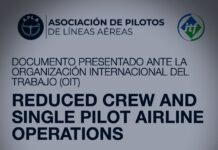Integrated Safety Management
With ever increasing amounts of data available for analysis by its safety experts, ICAO has begun to shift its focus toward the development of more measurable internal processes that will be tailored based on how substantially future data reflects their success in dealing with stakeholder-agreed, top-level safety concerns. Captain Daniel Maurino spoke recently with the Journal about this profound change now getting underway in ICAO as the Organizations Air Navigation Bureau seeks to ensure that it talks the talk and walks the walk when it comes to aviation safety.
For many years now, ICAO and the greater global aviation community have been developing programmes and tools to facilitate the collection of operational safety data relating to a variety of fields. Aviation safety has been one of the highest priority areas in this regard and, as the first complete cycle of the ICAO Universal Safety Operational Audit Programme (USOAP) under a comprehensive systems approach draws to its conclusion in 2010, the data that has been collected from this and other initiatives has
become a focal point for the consideration of ICAOs safety leadership as it contemplates how it will improve the Organizations design and development of safety-related programmes for the decades ahead.
ICAOs Air Navigation Bureau (ANB) holds primary responsibility for the Organizations fundamental safety initiatives and it is the ANB leadership that is now driving the paradigm shift in how ICAO will respond to and make use of the significant amount of safety data that has become increasingly accessible to its decision makers in recent years. As part of these fundamental safety initiatives, a new Section within the ANB, the Integrated Safety Management Section (ISM), has been recently formed to organize and effect changes related to safety management in the most efficient and cost-effective manner possible.
An Air Navigation Safety Group (ASG), composed of ICAO Officers selected on the basis of their expertise in areas of relevance to the safety management objectives of ICAO, supports the new ISM Section providing it with strategic vision and direction. The objectives of the ISM Section are to develop, with the support of the ASG, the Internal Safety Management Process (ISMP) and eventually an Integrated Safety System (ISS).
At the present time, the membership of the ASG includes Vince Galotti (ICAO structure and functions), Marcus Costa (accident/incident investigation), Henry Gourdji (safety auditing and oversight), Yuri Fattah (process control), Tom Mistos (data analysis), Miguel Ramos (safety management) and Dan Maurino (secretary of the ASG).
The ASG will be influential in determining how ICAO will begin to leverage the incredibly valuable safety data now at its disposal. Although the collection of this data in and of itself has been a monumental task in many respects, as will be the development of effective programmes and partnerships to ensure that new data continues to flow in a coordinated manner into ICAO, data alone will not solve some of the problems affecting safety-challenged States and the broader aviation community.
In many ways, aviation is data rich but still information poor, remarked Captain Dan Maurino, Chief of the ISM Section and formerly project manager of ICAOs Safety Management Systems (SMS) programme. ICAO and other external sources collect vast amounts of data but, until now, the aviation community as a whole has not spent an equal amount of energy on the analysis of and derivation of practical intelligence from this data. In the past this has generated situations where programmes have been launched that were founded as much on opinion as on the actual information that was available, which can have a negative impact on resource allocation and essentially means that our safety dollars are not being as well spent as they might be.
In the near term (Phase I—next 12 months), the ASG will first be soliciting stakeholder input with respect to possible methods that might be employed to integrate the safety data currently available from government and industry sources. The stakeholders will thus be composed of States/organizations with experience in safety data collection and analysis, and this integration would then enable the development by ICAO of a blueprint for a set of metrics to support the effective delivery of its safety services. These metrics would be specific to the needs of the ICAO business and perfor mance framework and would support the next generation of safety oversight audits that are expected to be based on the notion of continuous monitoring
Phase I is also planned to be used for the development of, or agreement on, a tool that will enable States to augment their safety data collection, analysis and exchange capabilities. This tool would be readily available and easily accessible by a large user community and would be designed to accommo date even those States with limited experience regarding safety data collection and analysis. An upcoming safety practitioners roundtable to be held at ICAO in early fall 2008 (September 16–17) will be used as a brain storming session on these topics by the participating States and organizations.
As developments progress, Phase II (24 months) of the ASGs current timetable would then see the consolidation of the Internal Safety Management Process (ISMP) at ICAO, while Phase III (36 months) would witness the development, deployment and management of Organization-level safety intelligence within ICAO leading to the development of the ICAO Integrated Safety System (ISS).
In a very basic sense ICAO is now undertaking a process similar to what it has been recommending States should pursue with respect to their own safety objectives, Maurino commented. The Organizations new pursuit of an ISM system reflects the understanding that internal processes need to be more data-responsive and that to properly inform our deliberations surrounding this evolution we also need to harmonize safety data collection and safety data convergence on an industry-wide basis.
Maurino went on to note that this process of mapping toplevel safety concerns and then measuring ICAOs
effectiveness in providing programmes and standards that deal effectively with the issues surrounding and supporting them is very similar to what it has been asking States to do with respect to the development of their own State Safety
Programmes (SSP), or to what it has been asking of industry when helping operators to employ Safety Management Systems (SMS). By measuring the effectiveness of its own processes and successes in this manner the ANB leadership is showing its determination to walk the walk as well as talk the talk when it comes to aviation safety. The new structure under discussion has as its initial, short term objective to deliver a blueprint of this internal safety management process by April of next year, against which ICAO will be able to measure the success of its activities in relationship to the list of top-level concerns based on the data being returned. It will then make targeted determinations about how it will be allocating future resources based on the information that the data will be providing. In a period of belt-tightening industry wide, Maurino concluded, these measures will go a long way to ensuring that ICAO is being as responsive and as effective as possible to the States and the industry it serves with respect to improving safety on a continuous, dynamic basis.
















